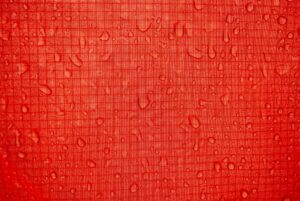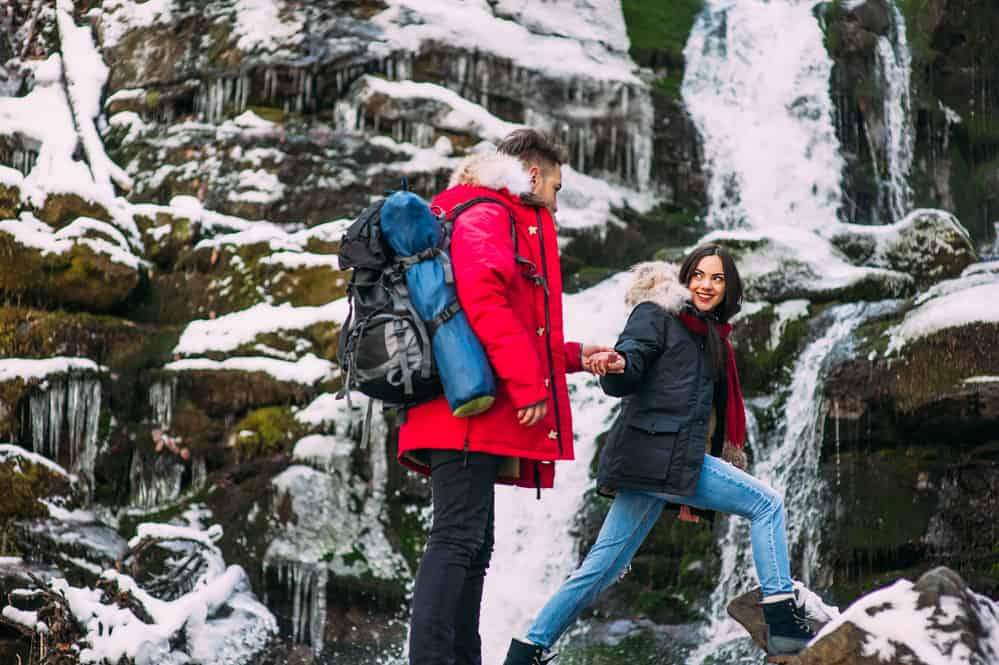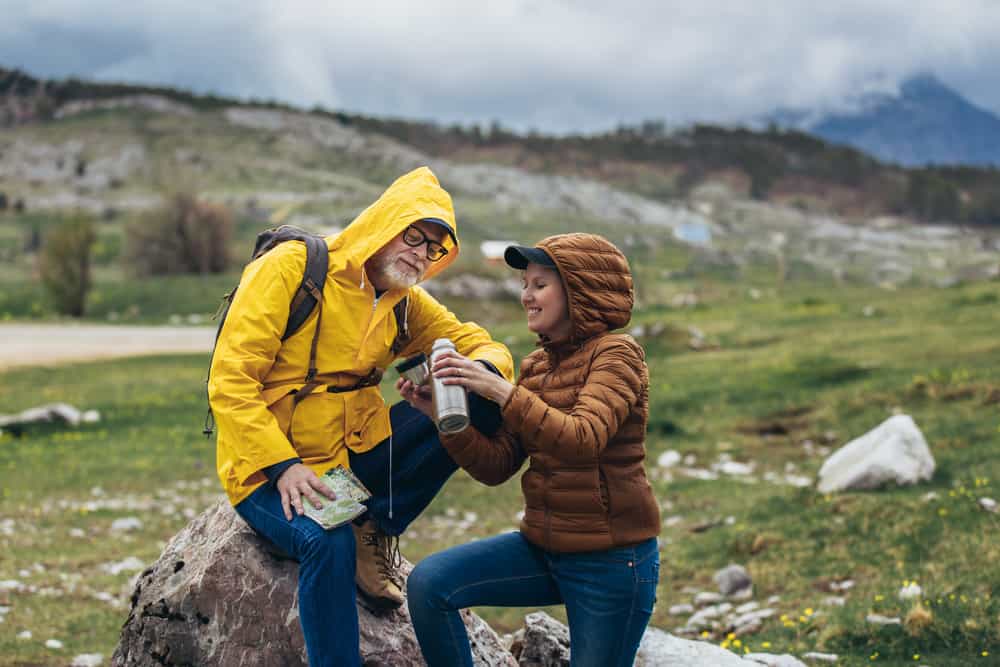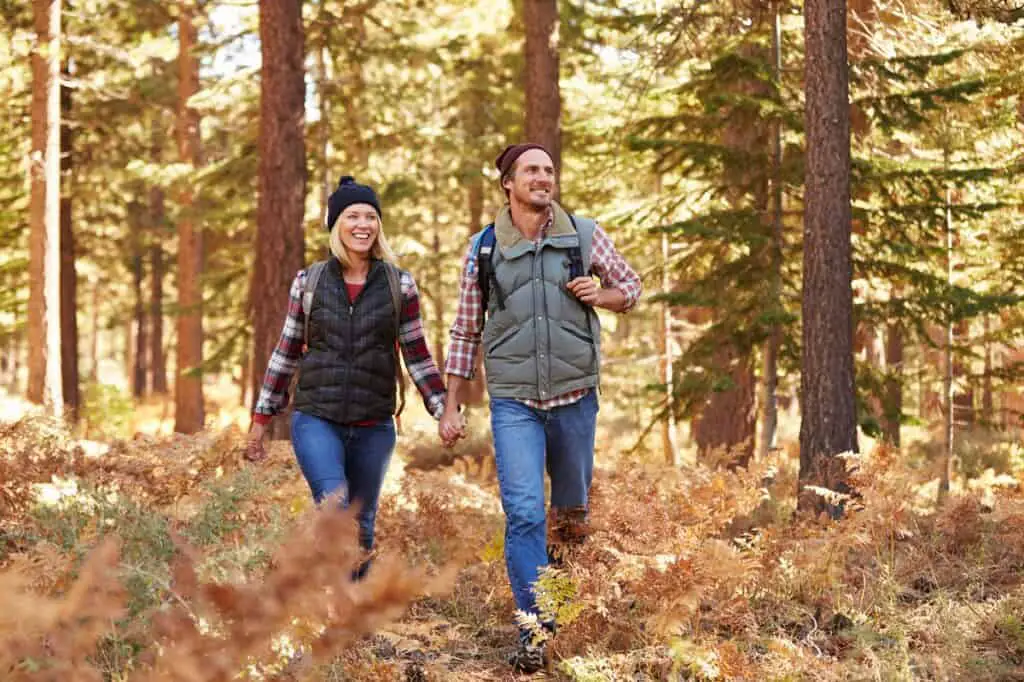It’s no secret that jeans are one of the most versatile and durable articles of clothing. They can be dressed up or down. And jeans are built to last. So it’s no surprise that some people might consider wearing them on a hike. But is it a good idea?
Most hiking articles will give a hard no to wearing jeans on the trail. But are they just a bunch of “Karens”? Or is there solid reasoning behind the push for wearing modern hiking pants? Maybe they are just a bunch of fashion snobs disguised as ruff and tuff outdoorsmen. Well, let’s figure it out.
Can You Hike in Jeans?
Of course, you can hike in jeans. To say you can’t is silly because you know darn well you are comfortable walking around all day in a pair of jeans. Hiking is just a walk in the woods, right?
Before you get too far… full disclosure is that Brad and I have hiked in jeans many times. Sometimes it worked and sometimes it didn’t. Let’s explore this.
The better question is: Should you wear jeans to hike?
And that answer depends upon a lot of factors such as
- What sort of weather are you likely to encounter while hiking in jeans?
- How long and far will you hike wearing jeans?
- Will the hiking trails be difficult and challenging?
Hiking in jeans is perfectly fine for a trip that isn’t much more work than a typical day of activity for you. A hike such as a simple short walk in the woods in great weather is the perfect time to hang on to your jeans.
We’ve hiked in jeans many times in fair weather. What’s more fun than lunch with friends followed by a short hike to your favorite stream? There’s no need to make a wardrobe change!
As you can probably guess, there are a lot of hiking situations where jeans don’t make sense. We are going to take a deep dive below.
What’s the Difference between Jeans and Hiking Pants
Fabric is the Biggest Difference
The main difference between jeans and hiking pants is in the fabric. The fabric in jeans is primarily cotton, while the material in hiking pants is primarily nylon. Both types are often made with a small blend of stretchy yarns like spandex and elastane to help the pants move more comfortably with you.
Jeans: To be authentic jeans, they need to be denim. Denim is primarily made of cotton. The heaviest jeans are 95-100% cotton, while lighter stretchy jeans are a cotton blend with 60-80% cotton and stretchy yarns like rayon and spandex blended into the fabric.
Hiking Pants: The fabric for these pants is nylon blended with varying amounts of stretch yarn like spandex and elastane. The material is usually ripstop nylon, a particular type of weave that makes the nylon stronger. You can see the cross-weave pattern easily in the ripstop.

Other Differences
Beyond the significant difference in fabric, you might find other differences in the structure of hiking pants compared to jeans. Most of these differences are in place to make your hike more comfortable. For example, hiking pants might have a gusseted crotch to allow greater stretch when climbing over rocks. Every pair of pants is slightly different in its features to improve comfort.

Looking for gift ideas for your favorite Hiker? Check out our Unique Guides!
Denim Jeans vs. Hiking Pants
I imagine you popped over to this article because you are trying to decide if you can wear your favorite denim jeans to hike or if you need to invest in a good pair of hiking pants. So let’s take a look at the key features of pants that are important for a comfortable and safe hike. We’ll compare how hiking in jeans compares to wearing hiking attire.
Style
Jeans: When it comes to style, wearing jeans is a big win. You can wear blue jeans practically everywhere, and they’ll look great. If you plan a day of sightseeing and touring along with several short hikes on your vacation, jeans will look good everywhere.
Hiking Pants: Hmm… not always so big on style. You’ll have to try on a lot of pants to find a pair of hiking pants that look as good on you like a snug pair of jeans.
Verdict: Jeans win
Durability on a Rugged Trail
You want your gear to be tough and rugged if you’re hiking. This is where jeans can go either way.
Jeans: Jeans of heavy denim will withstand some of the most challenging terrains. If you wear jeans, they can protect your legs from thorns and whipping branches without tearing.
Fibre to Fashion explains why denim is so strong quite well: “The durability comes from the weave known as twill weave. The blue yarns are the lengthwise or warp threads, and the white yarns run across the fabric width“. That results in a material that can withstand a lot of stress before the threads in the fabric break.
However, many modern styles of jeans, like the popular skinny jeans, are made from lighter-weight denim that easily rip. Remember the ripped jeans fashion craze? It only takes a puncture in these jeans to have them shred on a rough trail.
Hiking Pants: Quality pants for hiking use tear-resistant fabrics like rip-stop nylon. That’s the same fabric used in hot air balloons because that’s the last place you want the fabric to tear.
Verdict: It’s a toss-up, depending upon which jeans you want to wear and the ruggedness of the trail.
Flexible Comfort When Moving
Of all the essential features when hiking, comfort tops the list. Most importantly, when hiking, there is a lot of stretching, twisting and turning in the waist and hips.
Jeans: Unless you wear your favorite and well-worn jeans, the fabric can be stiff. The snug fit of the heavier denim fabric is often binding, restricting your movement. It’s common for jeans to chafe at the waistband.
Hiking Pants: Modern fabrics used in pants for hiking have more flexibility. For easier movement, gusseting in the crotch stops the pants from binding when you are bouldering or climbing stairs. And waists often stretch or have an adjustable integrated belt to avoid rubbing as you walk.
Verdict: In this category, wearing jeans isn’t even close to the top. Hiking pants will move with you as you traverse the trail.

Waterproof on Snowy and Rainy Days
Hiking in the rain or wet snow can make for a miserable day.
Jeans: Denim, even heavy denim, does not repel water. In fact, it will absorb water like a sponge and take forever to dry out. There are 3 significant problems with wet jeans:
- Wet jeans are heavy, and you’ll have to carry the extra weight of the water for the rest of the hike. That can be tiring.
- Wet pants will pull the heat away from your body and may end in causing hypothermia, even when the temperatures are above freezing.
- And in cold weather, that wet denim will quickly turn to the ice against your skin.
One of my worst hiking experiences was a day in denim shorts. I got soaked. Then that wet denim rubbed between my thighs for hours as I walked. Let’s just say I was in pain for days. That was the last time I wore jeans when there was a chance of rain.
Hiking Pants: You’ll find synthetic material in most pants that is quick-drying. Most also have a waterproof coating (DWR) that will shed rain or snow. You can always toss on a pair of waterproof rain pants over your hiking pants for those wet conditions. Rain pants will fit right over because they are lighter weight than jeans.
Verdict: Wearing wet jeans in the rain will suck. Hiking pants are the better option.
Windproof in Blustery Weather
Whether summiting a mountain or hiking along the coast, you’re likely to encounter some cold, blustery winds.
Jeans: The heavyweight denim in jeans offers some wind protection. As long as the jeans stay dry, they’ll help keep you warm. But, once you are wearing wet clothing, the wind will go right through the fabric and chill you to the bone.
Hiking Pants: The fabric in most pants for hiking will block the wind better than denim. The tight weave of the fabric stops the wind but still allows your skin to breathe.
Verdict: If you’re going to be in windy conditions, leave the blue jeans at home and grab a pair of hiking pants.
Thermal Insulation
When the temperature starts to drop, you’ll want some extra warmth. The best insulation is from clothing that creates tiny air pockets to trap warm air against your body when hiking. How do our pants perform here?
Jeans: The fashion editor at The Guardian says: “denim is rubbish for keeping you warm” in cold weather. That is because the tightly woven fabric leaves little space for trapped air to provide insulation. And when jeans get wet, they lose all insulation properties. Most important is that it’s often uncomfortable to add an insulating base layer under jeans because of the snug fit around the waist and hips.
Hiking Pants: The fabric in winter hiking pants has some loft or fluffiness that traps air to provide warmth, even when temperatures drop. Some also have thermal liners for extra warmth on cold days. Also, because they fit more comfortably, it’s much easier to tuck a merino wool base layer underneath for the second layer of protection from cold winds.
Verdict: If you’re going to be out in winter weather, don’t wear jeans. Hiking pants with a thermal base layer will keep you much warmer.
Cost
Cost is always a consideration, especially if you are new to hiking and not sure you want to make a significant investment right away. We know the backpack will set you back a little, so do you need to buy special hiking clothes?
Jeans: One of the most significant advantages of wearing jeans is their cost. Denim is a very inexpensive fabric, so jeans are usually quite affordable. And you likely already have many pairs in your closet. No need to run out to buy special pants for your hike.
Hiking Pants: Often made of more expensive synthetic materials, they can be quite costly. However, you can find pants to love among the best budget hiking pants with a bit of research.
Verdict: In this category, we have another toss-up. Hiking in jeans can save you money if you aren’t ready to invest. But don’t be afraid to try some of the light-weight, reasonably priced pants if you are novice hikers.
Breathability on hot, sweaty days
On hot summer days, it’s important to have clothing that will help you stay cool and comfortable. When your clothes are too heavy or not breathable, you can overheat, get sweaty, and end up with skin irritation.
Jeans: The heavyweight denim in jeans is not the most breathable fabric. In fact, it can trap heat in your body heat and make you quite uncomfortable on hot days. Elle Magazine lists denim as one of the worst fabrics you can wear in the summer because it isn’t breathable and makes you sweat more.
Hiking Pants: Most have lighter weight, more breathable, moisture-wicking fabric perfect for warm weather. That helps keep you cool and comfortable even when temperatures rise.
Verdict: If you’re going to be in hot weather, leave the jeans at home and grab a pair of hiking pants.
Quick Drying
Another important consideration for summer hikes is how quickly your clothes will dry if you get sweaty or encounter a little rain.
Jeans: Denim is a very absorbent fabric, so it can take quite a while for jeans to dry once they get wet. That’s not ideal when you’re out on the trail and need to stay dry and comfortable.
Hiking Pants: The Magic of Clothes study showed that nylon dried 3 times faster than cotton. Nylon is a hydrophobic material that doesn’t allow water molecules to attach to the fabric molecules. So not only does nylon not get as wet, but it also dries faster if it does get caught in a rainstorm.
Verdict: If you want clothes that dry quickly, wearing jeans is not the best choice. Hiking pants made with quick-drying fabrics are a better option.
UV and Sun Protection
Most people don’t think about UV protection when choosing clothes for a hike. But, if you’re going to be out in the sun all day, it’s important to have clothing that will help protect your skin from harmful UV rays.
Jeans: The tight, thick fibers of denim combined with the darker color results in a high natural UV protection, according to the EWG’s Sun Safety Campaign.
Hiking Pants: Nylon is somewhat UV resistant. But to ensure a safe hike in extreme sun, many hiking fabrics are treated for UV protection. That means they will help keep your skin safe from the sun’s harmful rays.
Verdict: If you’re looking for clothing that will offer UV protection, we assume you are headed out for a sunny hike. So even though jeans are naturally UV resistant, hiking pants that have been UV treated will provide the same protection and will be a lot cooler to wear.

How Do Jeans Fare for Hiking in Different Weather Conditions?
Hot Weather
Hiking in jeans in hot weather is a bad idea. The heavyweight cotton fabric can make you quite hot and uncomfortable. They also take a long time to dry if you get sweaty or caught in a rain shower. There’s nothing worse than the rash between your thighs from sweaty jeans rubbing all day. Look for cooler, lightweight and moisture wicking clothes for hiking in hot weather.
Cold Weather
Jeans are the worst insulators against cold temperatures. There are so many great hiking wardrobe options to keep warm when hiking in cold weather. You’ll feel a huge difference if you wear nylon pants as your outer layer and merino wool thermals underneath.
Wet Weather
Jeans are a horrible choice to wear hiking in wet weather. The cotton fabrics will absorb water and become very heavy. They will also take a long time to dry, which can be uncomfortable if you’re still on the trail. This scenario when wearing jeans is exactly why hikers say cotton kills.
Let’s Recap
The Advantages of Hiking in Jeans
- Denim is the stylish choice, hands down.
- Blue jeans are made of very durable fabric that can withstand a lot of abuse.
- They are cheaper than most hiking clothes.
- Denim is naturally UV resistant.
Disadvantages of Hiking in Jeans
- The heavy cotton materials in jeans are not very flexible, and many hikers find them uncomfortable.
- Denim is heavy and abrasive when wet.
- Blue jeans stay wet for a long time; cotton and cotton blends dry slowly.
- They are not waterproof or wind resistant.
- Jeans don’t breathe well, so they will hold in your own sweat and other moisture.
Final Thoughts
So, can you hike in jeans? The answer is yes. But, there are some things to consider before you head out on the trail, especially for longer hikes. Jeans are durable and cost-effective, but they can be heavy, binding, and uncomfortable. Hiking pants are usually more comfortable, but they can be expensive. Ultimately, the choice is up to you. Just make sure you consider the conditions you’ll be hiking in and choose the best-suited clothing for the task.
